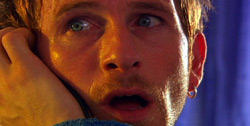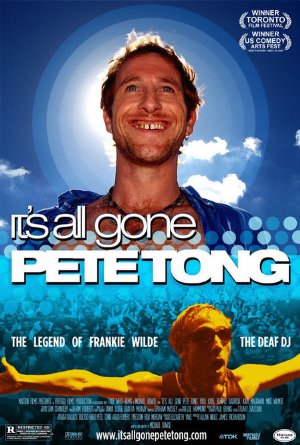It's All Gone Pete Tong Review
By byline.gif
Opening with an energetic blitz of Wilde's decadent, party-hardylifestyle (cocaine, booze, puking, orgies, stage-diving, magazine covers,Ibiza beach parties), the film follows his descent into a strung-out hellof wheels-falling-off-the-wagon self-pity after going stone deaf -- andthus losing his livelihood and his only real talent. But writer-directorMichael Dowse then taps into the revitalizing potency of a metrical andmetaphysical epiphany that brings Wilde (played with frazzled, hyperactivecharisma by Paul Kaye) roaring back to prominence before he disappearswithout a trace at the height of his fame.

The title is Cockney rhyming slang for "it's all gonewrong," and Kaye -- with his scruffy hair, unevenly angular face andoh-so-British teeth -- rides his character's foolishness and vitality likea racecar with 100,000 hard miles on its tires. He just keeps pushing andpushing even though he knows in the back of his head something's goingto blow. Wilde is so fried he's barely able to form a coherent sentencewhen he's living what he thinks is the good life.
Bad genetics and loud music conspire to bring him downto earth, and once his hearing is gone, he nose-dives toward rock bottomand fights his sometimes comically depicted demons. His coke habit is symbolizedby a guy in a badger suit literally shoveling white powder in his faceand beating him up.
When Wilde starts clawing his way out of this self-createdabyss, learning to lip-read from a beautiful girl leads to his rediscoveryof music purely through the physical manifestation of sound waves. He feelshis way back to DJ-ing through thumping bass lines, using improvised aideslike his bare feet propped up on subwoofers and a computer screen displayingoscillator-like feedback.
Writer-director Dowse layers "It's All Gone"in irreverent humor (it really takes the piss out of its hero, as the Britswould say), and savvy cinematography, editing and sound design providea view of Wilde's ups and downs from both outside and inside his head,both before and after he goes deaf.
The film pulsates with a contagious, carefree, colorfulrave-like beat, yet its darker sensibilities are always seeping in untilWilde rediscovers his gift for music and is not only revitalized, but alsobegins to evolve as an artist and grow up as a person. The wide-eyed exhilarationin Kaye's eyes as he begins mixing his first post-deafness demo (whichbecomes a celebrated album called "Hear No Evil") says it all.Dowse then uses this feeling as a jumping-off point to speculate on Wilde'sfate, as do several of his contemporaries -- including real DJs makingcameo appearances to add authenticity to the fiction -- in interviews woveninto the movie.
The one thing "It's All Gone Pete Tong" lacksis a sense of what makes Frankie Wilde a legend and a celebrity among DJs.As in far too many biopics about artists, Dowse includes Wilde's music,but doesn't explore it. Because the film quite successfully passes itselfoff as non-fiction (I was fooled until I did some serious internet homework),this feels like a shortcoming. But it's certainly not enough to ruin thefun.

Facts and Figures
Year: 2005
Genre: Dramas
Run time: 90 mins
In Theaters: Friday 27th May 2005
Box Office Worldwide: $120.6 thousand
Budget: $2M
Distributed by: Matson Films
Reviews
Contactmusic.com: 3 / 5
Rotten Tomatoes: 77%
Fresh: 54 Rotten: 16
IMDB: 7.4 / 10
Cast & Crew
Director: Michael Dowse
Starring: Paul Kaye as Frankie Wilde, Kate Magowan as Sonja, Neil Maskell as Jack Stoddart, Beatriz Batarda as Penelope
Also starring: Mike Wilmot, Pete Tong, Carl Cox, Steve Oram, Tiesto














